Notes
Question by Topic
Notes
This page contains the detailed and easy notes for AQA GCSE Chemistry Energy Changes for revision and understanding Energy Changes.
Banner 1AQA GCSE Paper 1: Complete Revision Summary
Energy Changes
Banner 24.5 Energy Changes
- Exothermic Reactions
- Endothermic Reactions
- Reaction Profile Diagrams
- Bond Energy Calculations
- Fuel Cells
TYPES OF REACTIONS
Law of conservation of energy states that energy is neither created nor destroyed. It just converts from one form to another.| Exothermic Reactions | ENDOTHERMIC REACTIONS |
| Reactions that releases heat to the surroundings. | Reactions that takes in heat from the surroundings |
| The reaction is accompanied by increase in temperature of the surroundings as the heat is released. | The reaction is accompanied by decrease in temperature of the surroundings as the heat is absorbed. |
| The product have the lower energy than the reactants. | The products have higher energy than the reactants. |
| Example: Combustion reaction and Respiration | Example: Thermal decomposition and -Photosynthesis |
| In terms of bond breaking the energy released in making the product is more than energy used up in breaking the reactants. | In terms of bond breaking the energy used in breaking the bonds of reactants is more than the energy released in making up of the products. |
| Used in self heating cans and hand warmers | Used in Ice packs made for sports injuries |
REACTION PROFILE DIAGRAM
Exothermic Reaction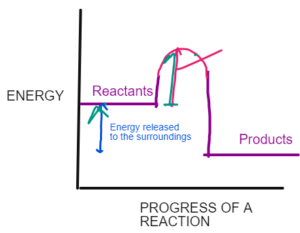
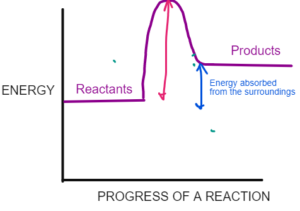 Defining Exothermic and Endothermic in terms of Bond making and Breaking
Defining Exothermic and Endothermic in terms of Bond making and Breaking
| Reactants | Products | ||
| Bonds are always broken in a reaction | Bonds are always made in a reaction. | ||
| Endothermic | Breaking of bonds of the reaction takes in heat | > | Making of bonds of the products Releases heat. |
| Exothermic | Breaking of bonds of the reaction takes in heat | < | Making of bonds of the products releases heat. |
BOND ENERGY CALCULATIONS !!
- Display the bonds of the reaction and the products
- Add the bond energies of the reactants and the products separately
- Take the difference of the two to calculate the heat energy associated with the reaction
| Bond | Energy |
| A-A | 221 |
| B-B | 325 |
| A-B | 425 |
Cells and Batteries
- Cell is a device that converts a chemical energy into an electrical energy.
- A simple cells contains two metal electrode dipped in an electrolytes.
- Difference in the reactivity of the two metals greater is the voltage produced.
- The more reactive metal donates electrons to the less reactive metal.
- The electrons flow from one side to another constituting current and electricity.
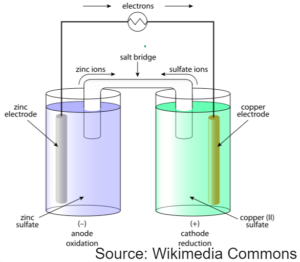
FUEL CELLS
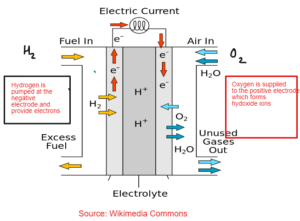 At the Negative Electrode
2H2(g) + 4OH–(aq) 4H2O(l) + 4e–
At the Positive Electrode
O2 + 2H2O + 4e– 4 OH–(aq)
Overall – 2H2(g) + O2 (g) 2H2O(l)
ADVANTAGES
At the Negative Electrode
2H2(g) + 4OH–(aq) 4H2O(l) + 4e–
At the Positive Electrode
O2 + 2H2O + 4e– 4 OH–(aq)
Overall – 2H2(g) + O2 (g) 2H2O(l)
ADVANTAGES
- No harmful gases or waste product is produced
- Waste product is only water so no problem to the environment or disposing off the waste product.
- Do not needs recharging
- Hydrogen is a flammable Gas
- Production of hydrogen depends on non renewable resources.
- Hydrogen being a gas is difficult to store and transport
- Storing and transport of hydrogen involves énergy which comes from fossils fuel thereby it contribute indirectly to -global warming.
Restricted download
×Key terms
Exothermic Reaction – The reaction which gives out heat to the surroundings. Example: Respiration or Combustion Endothermic Reaction – The reactions which taken in heat from the surrounding. Example: Photosynthesis or Thermal decomposition Reaction Profile – Diagramatic representation showing the relative energies of reactants and products in a reaction. Activation – Minimum energy required to start a reaction. Bond Energy – Heat energy contained in a bond between two atoms. Chemical Cells – A device that converts chemical energy into electrical energy. Fuel Cells – A chemical cells that uses a reaction between hydrogen and oxygen to form water and energy. Batteries – collection of cells. Label the reaction profile and classify it as Exothermic or Endothermic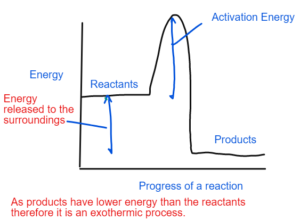
Draw Energy profile diagram of endothermic reaction
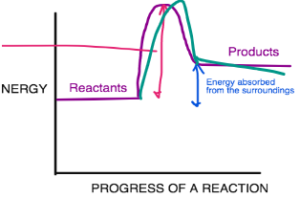
Give two application of exothermic and endothermic reaction
- Exothermic : Self heating cans and hand warmers
- Endothermic: Ice packs, self cooling cans
State the advantages and disadvantages of fuel cell.
ADVANTAGES- No harmful gases or waste product is produced
- Waste product is only water so no problem to the environment or disposing off the waste product.
- Do not needs recharging
-
- Hydrogen is a flammable Gas
- Production of hydrogen depends on non renewable resources.
- Hydrogen being a gas is difficult to store and transport
- Storing and transport of hydrogen involves energy which comes from fossils fuel thereby it contribute indirectly to global warming.
Question by Topic
Make sure you have watched the above videos and are familiar with the key definations before trying these questions. It is also good to time yourself while doing these questions so that you can work on the speed as well.
